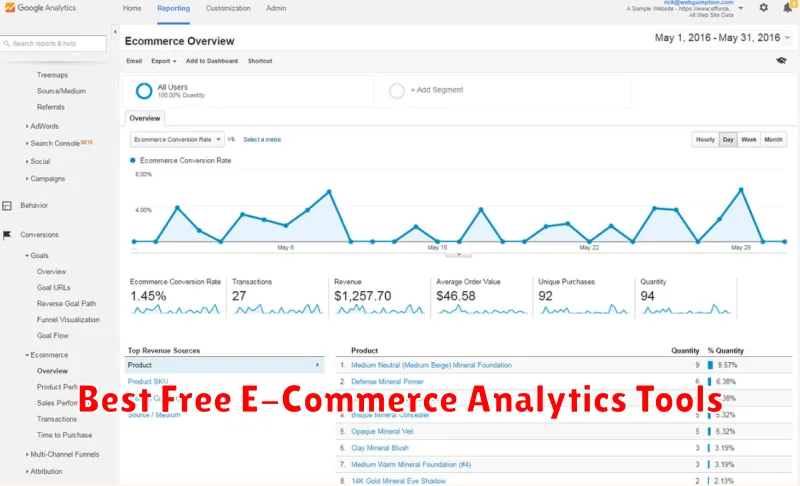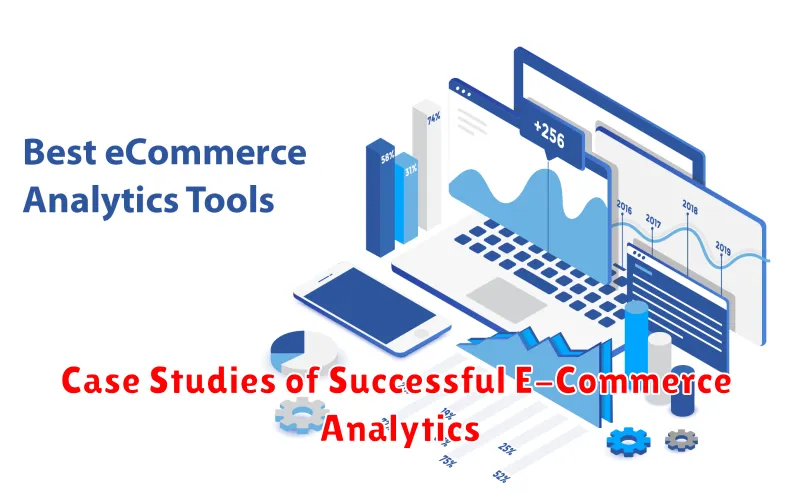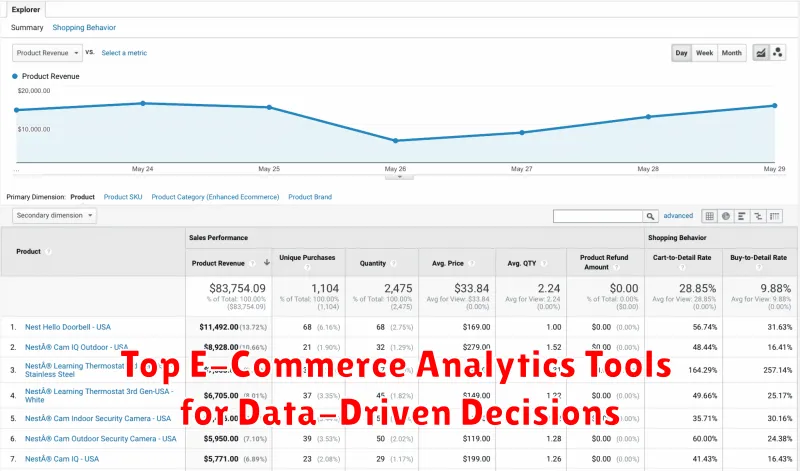In today’s competitive e-commerce landscape, data-driven decisions are no longer a luxury, but a necessity. To thrive and outperform competitors, businesses must leverage the power of e-commerce analytics tools. These tools provide invaluable insights into customer behavior, sales trends, marketing effectiveness, and overall business performance. By understanding the data, businesses can optimize their strategies, personalize customer experiences, and ultimately, drive revenue growth. Choosing the right e-commerce analytics tools is crucial for success, and this article will guide you through some of the top options available.
This article explores the leading e-commerce analytics tools that empower businesses to make informed decisions. From understanding website traffic and conversion rates to analyzing customer segmentation and product performance, these tools offer a comprehensive view of your e-commerce operations. We’ll delve into the features, benefits, and potential use cases of various platforms, enabling you to select the e-commerce analytics tools that best align with your specific business needs and objectives. Whether you’re a small startup or a large enterprise, understanding and leveraging your data is key to unlocking your full e-commerce potential.
The Importance of E-Commerce Analytics
In today’s competitive digital landscape, e-commerce analytics are essential for businesses to thrive. They provide valuable insights into customer behavior, sales trends, and overall business performance. By leveraging these insights, businesses can make data-driven decisions to optimize their strategies and achieve sustainable growth.
E-commerce analytics enable businesses to understand their customers better. By analyzing data such as website traffic, browsing history, and purchase patterns, you can identify your target audience, personalize marketing campaigns, and improve the overall customer experience.
Furthermore, analytics play a crucial role in identifying areas for improvement within your e-commerce operations. By tracking key performance indicators (KPIs) such as conversion rates, average order value, and customer lifetime value, you can pinpoint bottlenecks and optimize your sales funnel for maximum efficiency.
Ultimately, e-commerce analytics empower businesses to make informed decisions, reduce risks, and achieve a competitive edge in the market. By understanding the data, you can adapt to changing market dynamics and stay ahead of the curve.
Key Metrics to Track in E-Commerce
Tracking the right metrics is crucial for understanding your e-commerce performance and making informed decisions. Conversion rate is a fundamental metric, showing the percentage of visitors who complete a purchase. A low conversion rate may indicate issues with your checkout process or website usability.
Average order value (AOV) reveals the average amount spent per order. Increasing AOV can significantly boost revenue. Strategies include cross-selling, upselling, and offering free shipping thresholds.
Customer lifetime value (CLTV) predicts the total revenue a customer will generate throughout their relationship with your business. Understanding CLTV helps optimize marketing spend and customer retention efforts.
Cart abandonment rate measures the percentage of shoppers who add items to their cart but leave without completing the purchase. Analyzing this metric can identify pain points in the checkout process.
Customer acquisition cost (CAC) is the cost of acquiring a new customer. Keeping CAC low is essential for profitability. Analyze marketing campaign effectiveness to optimize spending and lower CAC.
Choosing the Right E-Commerce Analytics Tools
Selecting the appropriate e-commerce analytics tools is crucial for maximizing data insights and driving business growth. The ideal toolset depends heavily on specific business needs and objectives.
Business Size and Stage: Startups may benefit from simpler, free tools while larger enterprises often require more robust, paid solutions offering advanced functionalities and scalability.
Technical Expertise: Consider the team’s analytical skills. Some tools offer user-friendly interfaces, while others demand more technical proficiency.
Integration Capabilities: Seamless integration with existing platforms, such as your e-commerce platform, CRM, and marketing automation tools, is essential for a unified data view.
Budget: Analytics tools range from free options to premium solutions with varying pricing models. Carefully assess your budget limitations.
Reporting and Visualization: Choose tools that provide clear, customizable reports and visualizations to easily communicate data insights to stakeholders.
Features to Look for in an Analytics Platform
Selecting the right analytics platform is crucial for effective data analysis. When evaluating different options, consider these key features:
Data Integration
Seamless integration with your e-commerce platform, marketing tools, and other data sources is essential. Look for platforms that offer pre-built integrations or APIs for custom connections. This ensures a complete view of your customer journey.
Customization and Reporting
The ability to customize reports and dashboards is vital. Your chosen platform should allow you to tailor visualizations and metrics to your specific business needs. Look for features like drag-and-drop interfaces, custom report creation, and data segmentation.
Real-time Data Processing
Real-time data processing allows you to react quickly to changing market conditions and customer behavior. This feature is especially important for time-sensitive campaigns and promotions. Look for platforms that offer near real-time data updates.
Predictive Analytics
Advanced analytics platforms offer predictive capabilities, such as forecasting sales trends or identifying potential customer churn. These features leverage machine learning and statistical modeling to help you anticipate future outcomes and make proactive decisions.
Best Free E-Commerce Analytics Tools

Leveraging free analytics tools can provide valuable insights for e-commerce businesses on a budget. While premium tools offer advanced features, free options can be a great starting point for understanding key performance indicators.
Google Analytics
Google Analytics remains a powerful free tool offering comprehensive data on website traffic, user behavior, and conversions. It allows for tracking of key metrics like bounce rate, session duration, and conversion paths. Utilizing its robust reporting features can significantly improve your understanding of customer interactions.
Basic E-commerce Platform Analytics
Most e-commerce platforms offer built-in analytics dashboards. These dashboards typically provide data on sales, order value, and product performance. While simpler than dedicated analytics platforms, these tools offer convenient access to essential data.
Top Paid E-Commerce Analytics Platforms
Leveraging robust analytics is crucial for e-commerce success. Several paid platforms offer advanced features and in-depth insights to drive data-driven decisions. Here are some leading options:
Option 1: Platform A
Platform A focuses on providing granular data on customer behavior, including purchase patterns and website navigation. Its strength lies in segmentation and cohort analysis, allowing businesses to tailor marketing strategies effectively.
Option 2: Platform B
Platform B excels in real-time reporting and dashboard visualization. Its key features include customizable dashboards and automated reporting, facilitating quick access to key performance indicators (KPIs).
Option 3: Platform C
Platform C is a comprehensive suite offering a wide range of tools, from customer journey mapping to predictive analytics. Its advantage lies in its ability to integrate with various e-commerce platforms and marketing channels, providing a holistic view of business performance.
Integrating Analytics Tools with Your E-Commerce Store
Integrating analytics tools is crucial for maximizing their value. Most platforms offer various integration methods, allowing you to seamlessly connect your store’s data.
Direct integrations are often the simplest approach. Many platforms have pre-built integrations with popular e-commerce platforms like Shopify, Magento, and WooCommerce. These integrations typically involve installing a plugin or adding a snippet of code to your store’s theme.
API connections offer more flexibility and control. Using the platform’s API, you can customize the data you collect and how it’s integrated into your systems. This is ideal for businesses with complex data needs.
Tag management systems offer a streamlined way to manage multiple analytics and marketing tags. These systems simplify implementation and reduce the risk of errors in your tracking code.
Regardless of your chosen method, ensure your data is accurately tracked and that you follow data privacy regulations.
Using Data to Improve Your E-Commerce Strategy
Data analytics empowers e-commerce businesses to make informed decisions, optimizing every aspect of their operations. By analyzing key metrics, you can identify areas for improvement and drive growth.
Customer Segmentation: Analyze customer data to create targeted segments based on demographics, purchase history, and browsing behavior. This enables personalized marketing campaigns and product recommendations, increasing conversion rates.
Inventory Management: Track sales data to understand product performance and predict future demand. This helps optimize inventory levels, reducing storage costs and preventing stockouts or overstocking.
Pricing Optimization: Analyze competitor pricing and customer purchase patterns to determine the optimal pricing strategy. Data-driven pricing decisions can maximize revenue and profitability.
Website Optimization: Analyze website traffic and user behavior to identify areas for improvement in site navigation, user experience, and checkout processes. This can lead to increased conversion rates and reduced cart abandonment.
Case Studies of Successful E-Commerce Analytics

Examining real-world examples illustrates the impact of analytics on e-commerce success. These case studies demonstrate how data-driven decisions lead to measurable improvements.
Case Study 1: Personalized Product Recommendations
A clothing retailer implemented an analytics platform that tracked customer browsing behavior and purchase history. This data allowed them to provide personalized product recommendations, resulting in a 15% increase in conversion rates.
Case Study 2: Optimizing Pricing Strategies
An electronics store used analytics to analyze competitor pricing and customer price sensitivity. By dynamically adjusting their pricing strategies based on real-time data, they achieved a 10% increase in revenue.
Case Study 3: Improving Inventory Management
A home goods company leveraged analytics to forecast product demand and optimize inventory levels. This resulted in a 20% reduction in storage costs and a 5% decrease in stockouts.

